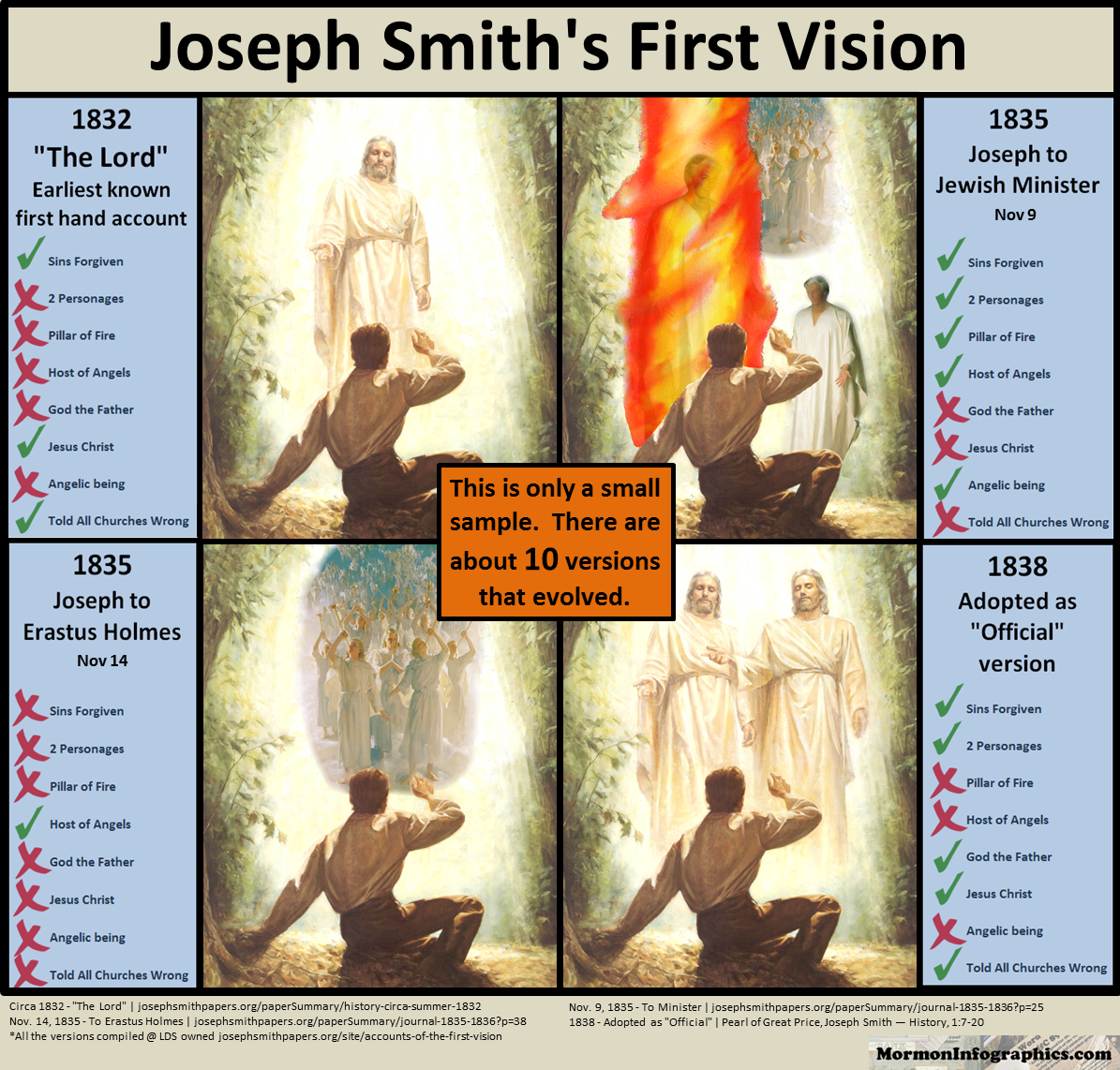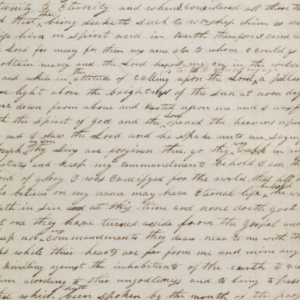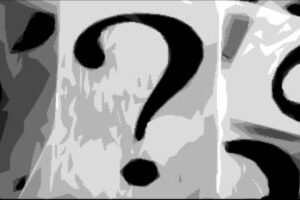“Our whole strength rests on the validity of that [First] vision. It either occurred or it did not occur. If it did not, then this work is a fraud. If it did, then it is the most important and wonderful work under the heavens.” – Gordon B. Hinckley, The Marvelous Foundation of Our Faith
1. Versions: The Church acknowledges there are at least nine different First Vision accounts by Joseph Smith, although the following five are the most widely-known accounts:
- 1832 account
- November 9, 1835 account
- November 14, 1835 account
- 1838 account (official version)
- 1842 account
2. Summary of First Vision accounts:
- 1832 Account
Joseph first hand-wrote the First Vision story in 1832. This version tells the story of a troubled young man who despairs of “the wickedness and abominations and the darkness which pervaded the minds of mankind.” Joseph claims that before visiting the grove, he had concluded that the world “had apostatised from the true and living faith” and that “there was no society or denomination built upon the Gospel of Jesus Christ as recorded in the New Testament.” Based on his reading of the Bible—although without mentioning any particularly inspiring text—Joseph decides to pray to God for guidance and forgiveness. This version of the story climaxes with an encounter with one divine being, identified as “the Lord,” but makes no mention of two separate personages. The Lord tells Joseph that his sins are forgiven and then confirms Joseph’s earlier suspicions about the corruption of Christianity. The vision abruptly closes, and Joseph notes that “none would believe my heavenly vision.”
- 1835 Accounts
On November 9, 1835, three years after Joseph’s hand-written first version account, Joseph provided another account. Joseph said that as a young man—“about 14”—he’d been perplexed by the diversity of religious views that existed in his neighborhood. Based on two specific biblical passages— Matthew 7:7 and James 1:5—he had sought God’s guidance. When telling the story, Joseph added a dramatic detail that he had not included in the 1830 or 1832 versions—an encounter with an invisible, malevolent force immediately preceding his conversation with God. First, he reported, his tongue became swollen, preventing him from praying aloud, and then he heard footsteps approaching. Hoping to find the source of the footfalls, he turned but saw no one. At precisely that instant, a “pillar of fire” descended, in which a divine being was visible. This being did not speak, but soon another being appeared who told Joseph that his sins were forgiven and “testified that Jesus Christ is the son of God.” Besides the two personages, Joseph claimed that he also saw “many angels” on this occasion.
Notably, Joseph does not identify the personages in the vision or claim that they were God and Jesus. In fact, Joseph seems to indicate that these personages may have been angels, as his November 14, 1835 account states that “I received the first visitation of Angels which was when I was about 14 years old,” but makes no mention of God or Jesus.
- 1838 Account
Joseph Smith dictated the most detailed variant of the First Vision in 1838. This version eventually became the canonical story included in the Pearl of Great Price.
Joseph’s motive for recounting his story was essentially defensive. He said he was attempting to counter the false rumors being spread about him and his church. This account is quite detailed, particularly in the attention it gives to the religious tensions that permeated Joseph’s environment—especially the atmosphere in the home he shared with his parents and siblings.
Joseph reports that revivals repeatedly swept through his home region prior to his vision. Several members of Joseph’s family, including his mother, had joined the Presbyterian Church. With a father disinterested in organized religion, and facing a rift between his own preferred denomination (Methodism) and that favored by his mother and siblings, young Joseph felt a keen sense of anxiety and even crisis concerning which denomination to join. Joseph recounts in this version that a specific scriptural text, James 1:5, struck his heart with unprecedented force and led him to seek God’s will on the matter.
This version tells of Joseph’s trek to the grove and, like the 1835 account, mentions an overpowering evil presence that binds his tongue. Joseph does not mention shadowy footsteps in this 1838 account, but he describes being violently “seized” by “some actual being from the unseen world” who refuses to relinquish him until the appearance of a pillar of light dispels it. The pillar contains two divine figures, one of whom introduces the other as “My Beloved Son” and enjoins Joseph to “hear him!” The message Jesus delivers in this version of the story conveys disdain for Christendom, its creeds, said to be an “abomination,” and its “professors,” said to be “corrupt.” Joseph is instructed to avoid all existing churches because they have no spiritual authority. Joseph recounts that he was also told “many other things,” which he was forbidden to write. He concludes by recalling that his eager recitation of these events drew the ire of the local “professors” of religion and incited a wave of “persecution” against him.
- 1842 Account
In 1842, Joseph responded to Chicago newspaper editor John Wentworth’s request for information about the Mormon faith. In most respects, the Wentworth Letter’s version of the First Vision is a faithful abbreviation of the 1838 account. The most significant difference is Joseph’s claim that, in addition to being told to join no existing sect, he was promised that “the fullness of the gospel should at some future time be made known unto me.”
3. Differences Among the Accounts: Joseph’s various First Vision accounts contain significant differences. For example:
- Perhaps the biggest problem is Joseph’s description of who actually appeared to him during the vision. His 1832 account states that he was visited by “the Lord” but makes no mention of two separate personages. Joseph’s November 9, 1835 account states that “a personage appeared in the midst of this pillar of flame” and, thereafter, “another personage appeared like unto the first.” Joseph does not identify these personages. However, Joseph suggests that these personages were angels, as his November 14, 1835 accounts states that “I received the first visitation of Angels which was when I was about 14 years old.” Joseph’s 1838 account, for the first time, explicitly mentions the appearance of God the Father and Jesus Christ.
- Joseph’s motivation in going to the grove changes among the various accounts. In one account he states he prayed for a forgiveness of his sins and makes no mention of being told that none of the churches on earth were true. In other accounts, he says he prayed due to the rival-like atmosphere, or because he desired to know if God existed. Yet in other accounts, Joseph claims he prayed to know which church to join.
For example, in the 1832 account, Joseph said that before praying he knew that there was no true or living church upon the earth as built by Jesus Christ in the New Testament. His primary purpose in going to pray was to seek forgiveness of his sins. However, in the official 1838 account, Joseph contradicts his 1832 account, stating his “object in going to inquire of the Lord was to know which of all the sects was right, that I might know which to join … (for at this time it had never entered into my heart that all were wrong).”
- Joseph’s brother, William Smith, and his mother, Lucy Mack Smith, both stated that the Smith family joined the Presbyterian Church after Alvin’s death in November 1823. This is significant, as it seems suspicious that Joseph and his family would join the Presbyterian church three years after Joseph claimed that God and Jesus told him that all of the churches on earth were “an abomination” and untrue.
- The historical record shows there was a revival in Palmyra in 1817 and 1824, but not in 1820.
- Joseph continued to hold and teach a Trinitarian view of the Godhead, as shown previously with the Book of Mormon, even after the First Vision. Why would he hold such a view if he saw that the Father and Son as separate embodied beings?
There are several charts comparing the various first vision accounts. Perhaps the best chart is compiled by Richard P. Howard, an historian emeritus of Community of Christ and pioneering scholar in Mormon history. Howard’s chart compares details from six of the first vision accounts. Another, more simplistic chart (comparing only four of the accounts) can be found below.

4. Joseph Never Mentioned Vision Until Years Later: No one, including Joseph Smith’s family members, ever heard about the First Vision for over 12 years after it supposedly occurred. There are no accounts in the newspapers, by neighbors, preachers, or even by members of Joseph’s own family. The first and earliest written account of the First Vision in Joseph Smith’s journal was written in 1832, 12 years after the spring of 1820, and that account did not even mention the presence of God. There is no record of a First Vision prior to that point.
Especially troubling is that the First Vision is not mentioned in either the official history of the church written in 1835 by Oliver Cowdery and Joseph Smith, or by Joseph’s own mother, Lucy Mack Smith, in the original version of her biographical sketch of Joseph. The First Vision was not taught in church until 22 years after it occurred.
Moreover, most Church members did not know about the First Vision until 1842, and even then it wasn’t regarded as very important. It is absent from early, fundamental Church documents like the Book of Commandments, which, at the time of publication, contained nearly every revealed doctrine and major historical account relevant to the Church. One would naturally expect the First Vision, the event that sparked Mormonism, to be included in the Book of Commandments.
James B. Allen, who served as assistant church historian, frankly admitted that the First Vision “was not given general circulation in the 1830’s” and indicated that the First Vision either never really happened or occurred very differently than what LDS leaders teach. (Dialogue: A Journal of Mormon Thought, Autumn 1966, p.33). In fact, Dr. Allen made a number of startling concessions in his interview with Dialogue, Vol.1, No.3, p. 31 — p.32. For example:
- “[N]one of the available contemporary writings about Joseph Smith in the 1830’s, none of the publications of the Church in that decade, and no contemporary journal or correspondence yet discovered mentions the story of the first vision.…” Dr. Allen also stated that in the 1830’s “the general membership of the Church knew little, if anything, about it.” Dialogue, Autumn 1966, pages 29–45.
- “As far as Mormon literature is concerned, there was apparently no reference to Joseph Smith’s first vision in any published material in the 1830’s. Joseph Smith’s history, which was begun in 1838, was not published until it ran serially in the Times and Seasons in 1842. The famous ‘Wentworth Letter,’ which contained a much less detailed account of the vision, appeared March 1, 1842, in the same periodical. Introductory material to the Book of Mormon, as well as publicity about it, told of Joseph Smith’s obtaining the gold plates and of angelic visitations, but nothing was printed that remotely suggested earlier visitations.”
- “In 1833 the Church published the Book of Commandments, forerunner to the present Doctrine and Covenants, and again no reference was made to Joseph’s first vision, although several references were made to the Book of Mormon and the circumstances of its origin.”
- “The first regular periodical to be published by the Church was The Evening and Morning Star, but its pages reveal no effort to tell the story of the first vision to its readers. Nor do the pages of the Latter-day Saints Messenger and Advocate, printed in Kirtland, Ohio, from October, 1834, to September, 1836. In this newspaper Oliver Cowdery, who was second only to Joseph Smith in the early organization of the Church, published a series of letters dealing with the origin of the Church. These letters were written with the approval of Joseph Smith, but they contained no mention of any vision prior to those connected with the Book of Mormon.
- “In 1835 the Doctrine and Covenants was printed at Kirtland, Ohio, and its preface declared that it contained ‘the leading items of religion which we have professed to believe.’ Included in the book were the ‘Lectures on Faith,’ a series of seven lectures which had been prepared for the School of the Prophets in Kirtland in 1834–35. It is interesting to note that, in demonstrating the doctrine that the Godhead consists of two separate personages, no mention was made of Joseph Smith having seen them, nor was any reference made to the first vision in any part of the publication.”
- “The first important missionary pamphlet of the Church was the Voice of Warning, published in 1837 by Parley P. Pratt. The book contains long sections on items important to missionaries of the 1830’s, such as fulfillment of prophecy, the Book of Mormon, external evidence of the book’s authenticity, the resurrection, and the nature of revelation, but nothing, again, on the first vision.”
- “The Times and Seasons began publication in 1839, but, as indicated above, the story of the vision was not told in its pages until 1842. From all this it would appear that the general church membership did not receive information about the first vision until the 1840’s and that the story certainly did not hold the prominent place in Mormon thought that it does today.”
5. Joseph Enhanced First Vision Account to Stave off Leadership Crisis: As documented by Grant Palmer in An Insider’s View of Mormon Origins, the historical record suggests that Joseph had important personal considerations in changing and bolstering the various first vision accounts. As previously mentioned, prior to 1838, Joseph was rather vague in his description of the first vision. However, a leadership crisis began in Kirtland on November 7, 1837. Frederick G. Williams, a counselor in the First Presidency, left the church. (Joseph Field Smith, Essentials in Church History, p. 204, 689.) During the last week of December 1837, Martin Harris, one of the three witnesses, was excommunicated. On March 10, 1838, John Whitmer, one of the eight witnesses to the Book of Mormon, was excommunicated. On March 25, Martin Harris told a public meeting that none of the witnesses had physically seen or handled the plates; they had not seen the plates with their “natural eyes.” (Stephen Burnett to Lyman E. Johnson, April 15, 1838, Joseph Smith Letterbook, 2: 64–66, LDS archives.) His admission (which is discussed in the Witnesses section of this document) triggered a discussion among church leaders as to future of the Church. Shortly thereafter, Apostles John F. Boynton, Luke Johnson, and other church members “renounced the Book of Mormon.” (Burnett to Johnson, April 15, 1838.)
George Albert Smith attended this last discussion or meeting and wrote, on March 30, 1838: “Last Sabbath a division arose among the Parrish party about the Book of Mormon. John Boyington, W. Parrish, Luke Johnson and others, said it was nonsense.” (George A. Smith to Josiah Flemming, March 30, 1838, Journal History of the Church.) George Albert Smith further recalled that about “thirty … prominent Elders” belonging to the Parrish group, including Apostles Lyman Johnson, William McLellin, and others “renounce[d] the Book of Mormon and Joseph Smith.” (George A. Smith, Journal of Discourses, 7:115.) By April 7, 1838, when a church conference was held at Far West under Joseph’s direction, five apostles were said to be out of harmony with the church, including William Smith, William E. McLellin, Luke Johnson, Lyman Johnson, and John F. Boynton.
On April 13, 1838, Apostles Luke Johnson, Lyman E. Johnson, and John F. Boynton were excommunicated or left the church. William McLellin followed shortly thereafter. They were the first four apostles to leave, and three of them – Boynton and the Johnson brothers – no longer believed in the divine authority of the Book of Mormon. Oliver Cowdery and David Whitmer were excommunicated on April 12–13, 1838, and Hiram Page and Jacob Whitmer (also witnesses to the Book of Mormon) left the church as well. By the fall of 1838, Apostles Thomas B. Marsh and Orson Hyde had defected.
According to Dean C. Jessee, “During this time of apostasy, approximately three hundred left the Church, representing about 15 percent of the Kirtland membership.” (Jessee, Papers of Joseph Smith, 2: 217 n. 2.) Economic disillusionment over the failure of the Kirtland Anti-Safety Society may have fueled the dissent, but doctrinal disillusionment stemming from Martin Harris’ statements and the subsequent debate over the Book of Mormon smoldered long afterwards.
Within a month after Martin Harris’ admitted that the Book of Mormon witnesses had not physically seen the plates, three apostles no longer believed in the Book of Mormon and two more were out of favor with the church. All three Book of Mormon witnesses and three of the eight witnesses had defected. The entire Whitmer clan had left the church. All of this must have caused considerable anxiety and cognitive dissonance within the LDS community. Fearing the possible unraveling of the church, Joseph Smith took to reestablishing his authority. During the week of April 7–13, 1838, he contemplated re-writing his history. (Jessee, Papers of Joseph Smith, 2: 226–27.) On April 26, he renamed the church. The next day, he started dictating a new first vision narrative. Id. at 232–33; D&C 115: 3–4.
Joseph began his 1838 account by attacking those who were circulating unsavory “reports” regarding “the rise and progress of the Church,” and then told a revised and more impressive version of his vision. (JS-History 1:1.) He announced that his initial calling had not come from an angel in 1823, as he had claimed for over a decade, but from God the Father and Jesus Christ in 1820. (JS-History 1:28.) This earlier date established his mission independent of the troubling questions and former witnesses associated with the Book of Mormon. Like the 1834–35 priesthood restoration recitals (discussed hereafter), Joseph’s April 1838 first vision account added significant material that bolstered his authority during a time of crisis.
6. Joseph Smith Taught Trinity Following First Vision: The historical record establishes that Joseph Smith held a Trinitarian view of the Godhead long after the First Vision, which doesn’t seem possible if he, in fact, saw God and Jesus. Consider an outline of a lecture Grant Palmer presented on November 6, 2013 discussing Joseph Smith’s changing view of God as seen in his First Vision accounts. The lecture presents compelling evidence that Joseph Smith believed the following:
- Joseph Smith believed in one God from 1829–1834.
- Joseph Smith believed in two separate Gods from 1835–1839.
- Joseph Smith believed in a plurality of Gods from 1839–1844.
Overall, the lecture persuasively presents evidence of the following:
- Joseph Smith wrote pseudepigrapha, in that he falsely attributed his view of the Godhead to Biblical prophets. In fact, Joseph altered past scripture to reflect his own changing view of God.
- Joseph, by imposing his own view of God (and other beliefs) upon past eras of scripture and upon his own first vision accounts, validates that one cannot trust what Smith altered in the writings of past prophets—or his own.
- Joseph, by materially changing his First Vision story, reveals the pattern of conduct that he applied to all four of his foundational visions, each of which are discussed in this document and include (1) obtaining the gold plates from Moroni; (2) the priesthood restoration, and (3) the First Vision. All follow the embellished pattern of becoming more physical, impressive, unique, and miraculous as time went on.



